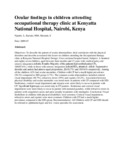Ocular findings in children attending occupational therapy clinic at Kenyatta National Hospital, Nairobi, Kenya

View/
Date
2009-07Author
Njambi, L
Kariuki, MM
Masinde, S
Language
enMetadata
Show full item recordAbstract
Objectives: To describe the pattern of ocular abnormalities, their correlation with
the physical disorders and describe associated risk factors in children attending the
Occupational therapy clinic at Kenyatta National Hospital.
Design: Cross sectional hospital based.
Subjects: A hundred and eighty seven children, aged between three months and 13
years with cerebral palsy and sensory integration deficits.
Results: Majority of the patients had cerebral palsy(CP), 160(85.6%), while in
those with sensory integration deficit(SID), attention- deficit / hyperactive disorder
and autism had almost equal proportions, 20(10.7%) and 18(9.6%) respectively.
Among all the children, 62% had ocular anomalies. Children with CP had a much
higher prevalence (58.3%) compared to SID group (3.7%). The common ocular
abnormalities included cortical visual impairment (48.7%), refractive errors (39%)
and squints (34.2%). Association between physical disability and ocular anomalies
was noted more in patients with CP compared with SID. Strabismus, cortical visual
impairment and myopia were more likely to occur in patients with CP. Significant
hyperopia was noted only in CP patients. Strabismus and cortical visual impairment
were more likely to occur in patient with neonatal jaundice, while refractive errors
in patients with congenital causes and optic atrophy in patients with meningitis.
Conclusion: Visual disabilities in children with physical disabilities were common.
Cortical visual impairment, refractive errors and squints were more common.
Children with CP had a much higher prevalence compared to the SID group.
Recommendation: All Children with CP and SID should be referred to ophthalmologist
and low vision specialist for assessment.
Collections
- Faculty of Health Sciences (FHS) [10378]
